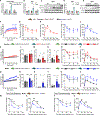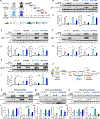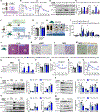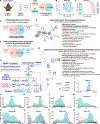m6A mRNA methylation in brown fat regulates systemic insulin sensitivity via an inter-organ prostaglandin signaling axis independent of UCP1
- PMID: 39255799
- PMCID: PMC11891809
- DOI: 10.1016/j.cmet.2024.08.006
m6A mRNA methylation in brown fat regulates systemic insulin sensitivity via an inter-organ prostaglandin signaling axis independent of UCP1
Abstract
Brown adipose tissue (BAT) regulates systemic metabolism by releasing signaling lipids. N6-methyladenosine (m6A) is the most prevalent and abundant post-transcriptional mRNA modification and has been reported to regulate BAT adipogenesis and energy expenditure. Here, we demonstrate that the absence of m6A methyltransferase-like 14 (METTL14) modifies the BAT secretome to improve systemic insulin sensitivity independent of UCP1. Using lipidomics, we identify prostaglandin E2 (PGE2) and prostaglandin F2a (PGF2a) as BAT-secreted insulin sensitizers. PGE2 and PGF2a inversely correlate with insulin sensitivity in humans and protect mice from high-fat-diet-induced insulin resistance by suppressing specific AKT phosphatases. Mechanistically, METTL14-mediated m6A promotes the decay of PTGES2 and CBR1, the genes encoding PGE2 and PGF2a biosynthesis enzymes, in brown adipocytes via YTHDF2/3. Consistently, BAT-specific knockdown of Ptges2 or Cbr1 reverses the insulin-sensitizing effects in M14KO mice. Overall, these findings reveal a novel biological mechanism through which m6A-dependent regulation of the BAT secretome regulates systemic insulin sensitivity.
Keywords: METTL14; brown fat; human; insulin sensitivity; inter-organ communication; m(6)A; prostaglandins.
Copyright © 2024 Elsevier Inc. All rights reserved.
Conflict of interest statement
Declaration of interests R.N.K. is on the scientific advisory boards of Novo Nordisk, Biomea, Inversago, and REDD. C.H. is a scientific founder and a member of the scientific advisory board of Accent Therapeutics. M.B. received honoraria as a consultant and speaker from Amgen, AstraZeneca, Bayer, Boehringer Ingelheim, Lilly, Novo Nordisk, Novartis, Pfizer, and Sanofi.
Figures







Update of
-
m 6 A mRNA Methylation in Brown Adipose Tissue Regulates Systemic Insulin Sensitivity via an Inter-Organ Prostaglandin Signaling Axis.bioRxiv [Preprint]. 2023 May 26:2023.05.26.542169. doi: 10.1101/2023.05.26.542169. bioRxiv. 2023. Update in: Cell Metab. 2024 Oct 1;36(10):2207-2227.e9. doi: 10.1016/j.cmet.2024.08.006. PMID: 37292780 Free PMC article. Updated. Preprint.
References
MeSH terms
Substances
Grants and funding
LinkOut - more resources
Full Text Sources
Molecular Biology Databases
Research Materials
Miscellaneous

